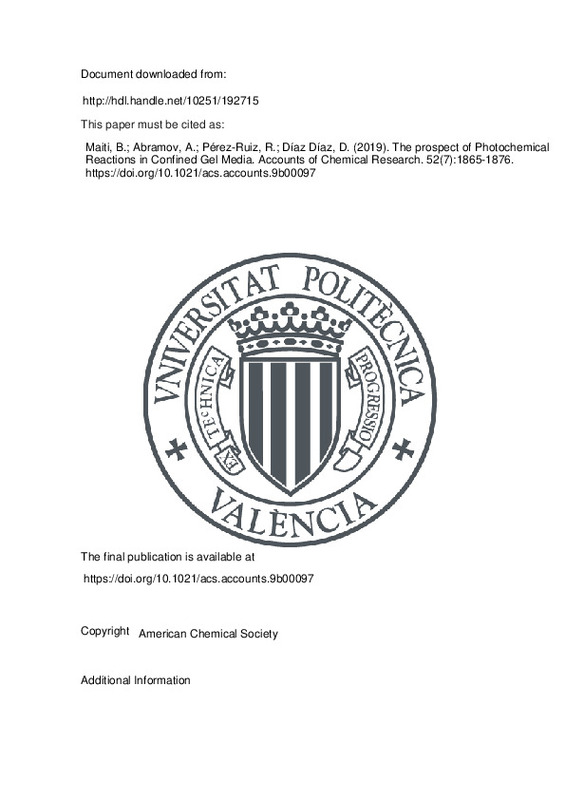JavaScript is disabled for your browser. Some features of this site may not work without it.
Buscar en RiuNet
Listar
Mi cuenta
Estadísticas
Ayuda RiuNet
Admin. UPV
The prospect of Photochemical Reactions in Confined Gel Media
Mostrar el registro sencillo del ítem
Ficheros en el ítem
| dc.contributor.author | Maiti, Binoy
|
es_ES |
| dc.contributor.author | Abramov, Alex
|
es_ES |
| dc.contributor.author | Pérez-Ruiz, Raúl
|
es_ES |
| dc.contributor.author | Díaz Díaz, David
|
es_ES |
| dc.date.accessioned | 2023-04-05T18:00:40Z | |
| dc.date.available | 2023-04-05T18:00:40Z | |
| dc.date.issued | 2019 | es_ES |
| dc.identifier.issn | 0001-4842 | es_ES |
| dc.identifier.uri | http://hdl.handle.net/10251/192715 | |
| dc.description.abstract | [EN] Nature is intrinsically able to control kinetics, conversion, and selectivity of biochemical processes by means of confined reaction environments such as enzyme pockets, bilayer membranes, micelles, vesicles, cells, or bioorganic frameworks. The main reason for this fact is the optimal molecular alignment and restricted motion of reactant molecules compared to those found in bulk solution. Under this inspiration, a number of synthetic photo-nanoreactors based on supramolecular self-assembled systems have been developed during the last decades, including mesoporous inorganic materials, microemulsions, micelles, vesicles, lipid bilayer foams, polyelectrolyte nanoparticles, etc. In a broader sense, nanoreactor technology constitutes nowadays a promising tool to enhance organic synthesis under sustainable reaction conditions. In general, nanoreactors change the essential properties of the molecules within them, thus affecting their chemical reactivity. Among the nanoreactor-like systems described in the literature to facilitate photochemical processes, the more recent use of viscoelastic supramolecular gels, typically made of low-molecular-weight (LMW) compounds self-assembled through noncovalent interactions, as compartmentalized reaction media is particularly appealing due to the versatility of these materials in terms of fabrication, properties, and processability. Furthermore, the high specific surface areas found in supramolecular gels, their stimuli-responsive reversibility, good diffusion properties enhancing the interactions between reactants and the three-dimensional (3D) porous network, functional tunability, and blocking effect of external oxygen are some of the most important features that can benefit photoinduced processes carried out in confined gel media. Not surprisingly, the efficiency of photochemical processes inside gel media is largely dependent on the type of reaction, characteristics of the gel network, solvent nature, reactant properties, and reaction conditions. Thus, the main focus of this Account is to provide a concise overview of the most relevant examples reported by us and others in order to illustrate the main advantages associated with the emerging use of gel-based materials as nonconventional reaction media to facilitate and control photochemical reactions. In particular, photodimerization, triplet-triplet annihilation upconversion (TTA-UC) coupled to single electron transfer (SET), photooxidation, photoreduction, and trifluoromethylation reactions will be illustrated during the discussion. These examples suggest that gel-based media can provide a versatile platform for the discovery of new reaction pathways and facilitate the way that photochemical reactions are traditionally carried out in academia and industry in terms of reaction conditions and required infrastructure. In addition, the use of physical or chemical gels as reaction systems may also accelerate high-throughput screening of photocatalysts. Overall, a judicious choice of gelators, reactants, solvent, and reaction conditions for the assembly of these gelators is crucial for controlling conversion, kinetics, and selectivity of intragel photoinduced processes. | es_ES |
| dc.description.sponsorship | The authors are grateful for the financial support from the University of Regensburg. R.P.-R. thanks Valencian Community (Grant No. CIDEGENT/2018/044). D.D.D. thanks the DFG for the Heisenberg Professorship Award | es_ES |
| dc.language | Inglés | es_ES |
| dc.publisher | American Chemical Society | es_ES |
| dc.relation.ispartof | Accounts of Chemical Research | es_ES |
| dc.rights | Reserva de todos los derechos | es_ES |
| dc.subject | Irradiation | es_ES |
| dc.subject | Luminescence | es_ES |
| dc.subject | Oxygen | es_ES |
| dc.subject | Photocatalysts | es_ES |
| dc.subject | Photochemical reactions | es_ES |
| dc.subject.classification | QUIMICA ORGANICA | es_ES |
| dc.title | The prospect of Photochemical Reactions in Confined Gel Media | es_ES |
| dc.type | Artículo | es_ES |
| dc.identifier.doi | 10.1021/acs.accounts.9b00097 | es_ES |
| dc.relation.projectID | info:eu-repo/grantAgreement/GENERALITAT VALENCIANA//CIDEGENT%2F2018%2F044//PHOTON UPCONVERSION REDOX CATALYSIS/ | es_ES |
| dc.rights.accessRights | Abierto | es_ES |
| dc.contributor.affiliation | Universitat Politècnica de València. Escuela Técnica Superior de Ingenieros Industriales - Escola Tècnica Superior d'Enginyers Industrials | es_ES |
| dc.description.bibliographicCitation | Maiti, B.; Abramov, A.; Pérez-Ruiz, R.; Díaz Díaz, D. (2019). The prospect of Photochemical Reactions in Confined Gel Media. Accounts of Chemical Research. 52(7):1865-1876. https://doi.org/10.1021/acs.accounts.9b00097 | es_ES |
| dc.description.accrualMethod | S | es_ES |
| dc.relation.publisherversion | https://doi.org/10.1021/acs.accounts.9b00097 | es_ES |
| dc.description.upvformatpinicio | 1865 | es_ES |
| dc.description.upvformatpfin | 1876 | es_ES |
| dc.type.version | info:eu-repo/semantics/publishedVersion | es_ES |
| dc.description.volume | 52 | es_ES |
| dc.description.issue | 7 | es_ES |
| dc.identifier.pmid | 31016963 | es_ES |
| dc.relation.pasarela | S\397239 | es_ES |
| dc.contributor.funder | GENERALITAT VALENCIANA | es_ES |
| dc.contributor.funder | Universität Regensburg | es_ES |
| dc.contributor.funder | Deutsche Forschungsgemeinschaft | es_ES |







![[Cerrado]](/themes/UPV/images/candado.png)

